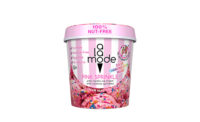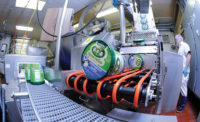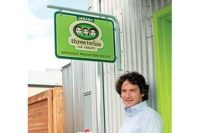
That brewery’s most interesting man in the world has some company. Meet Neal H. Gottlieb. This ice cream company executive:
- Traveled to the wilds of Cambodia to be a contestant on the television program Survivor. (He didn’t win but left with a staph infection on his leg.)
- Scaled the highest peak in Uganda in order to be photographed with the gay pride flag to protest that country’s ban on homosexuality. Then he published the photo and his open letter to the president of Uganda on Facebook. The Huffington Post, among other news sites, wrote about it.
- Hauled a rainbow-colored outhouse adorned with a Trans Pride flag to Mount Mitchell (North Carolina’s highest peak) to protest the state’s controversial bathroom bill and left it there with an open letter to then Gov. Mike McCrory.
The founder of Three Twins Ice Cream smiled when he talked about these “shenanigans,” as he called them. Gottlieb said he doesn’t undertake these actions to promote the company, but they do result in greater visibility for the brand. Equal rights is just something Gottlieb believes in.
Though these activities have taken him away from company headquarters in Petaluma, Calif., they have not distracted him from growing Three Twins Ice Cream into the leading brand of organic ice cream in just 10 years. In the course of a decade, Gottlieb went from a scoop shop to owning manufacturing facilities in California and Wisconsin. A Three Twins cause-marketing program has conserved 8,000 acres of rain forest in South America. Through another program, the company donates 1% of its sales to environmental groups.
Gottlieb turns 40 in February. He said there is plenty more for him to do. He does not want to stay a small company.
“I’d love to go from $13 million to $200 million” [in annual sales], he said. “I’d love to have Three Twins available for sale every place that the two big brands are available. I’d really like to be that third truly prominent American ice cream brand.”
Recently, he brought in equity investors who are funding the growth and expansion (but he remains the largest shareholder). In 2013, the equipment in the former Zurheide ice cream plant in Sheboygan, Wis., was to be auctioned. Gottlieb bought it all, lock, stock and barrel. Then he bought the plant itself. Gottlieb needed more capacity to keep up with demand. (See related article)
For Three Twins, growth will come from selling pints of packaged ice cream, not by expanding the scoop shop network, he said.
“We’re looking to continue to grow to be a major American ice cream brand. I wanted to build a brand. I wanted to make great organic stuff accessible. I wanted to have more impact than I would have with a small company. I never wanted to be Old Man Gottlieb at the ice cream shop when I was 65 years old or so.”
On the shelf
Three Twins is a premium-priced organic ice cream with 14% butterfat and 50% overrun. But “organic” is not the main selling point, Gottlieb said.
When he makes a sales call, he tells the buyers, “It’s inconceivably delicious. And it has a clean ingredient statement. It’s local organic milk. It doesn’t have stabilizers. There’s a real authentic story behind the brand. We give back with every pint. We have our own land conservation initiative, Ice Cream For Acres. And, by the way, it also happens to be organic.”
Gottlieb built a strong brand in Northern California because he’s been operating there for 11 years.
“We have half of a generation now that’s grown up with Three Twins that knows it and loves it. To give somebody that brand experience is irreplaceable. And it gets ingrained in their memory and their psyche. It almost becomes part of who you are,” he said.
The brand is sold nationwide, thanks in part to United Natural Foods Inc. which distributes products to more than 45,000 customer locations in United States and Canada. There is also a distributor in New York. Gottlieb estimates that about 5,000 retail stores carry Three Twins ice cream and cones. Whole Foods is a customer.
There is very little advertising. Instead, the company relies on social media marketing and periodic promotional pricing. Trade show marketing includes the Fancy Food Shows on the West and East Coasts and smaller regional trade shows.
Who are the consumers? Gottlieb said they fall into all age groups but they share a common trait: they read ingredient statements.
“They want something better. They have put value on organic. They have put a value on cleanliness and simplicity in ingredients,” he said. “And then it’s the group of people with taste buds. It’s the people that are willing to pay a little bit extra for a really great product. It’s not the commoditized consumer. We don’t compete like that.”
An analysis from the market research firm Mintel stated that “organic” ranks low as a purchase driver for ice cream. Brands have “to clarify what that word means, and justify the reason prices are often more expensive,” wrote analyst Alex Beckett.
Marketing environmental causes
Three Twins makes a variety of flavors which it packs in pints, quarts and tubs. Last year was “the year of the cone,” Gottlieb said. Three Twins introduced a sundae cone (ice cream, chocolate coating and nuts), which is made in Wisconsin. The company also developed dry cones sold under the Three Twins name. These are manufactured by a contract manufacturer.
The organic food market continues to grow. It has moved from a niche market into the mainstream. Organic dairy is the second largest segment in the organic food category, according to the Organic Trade Association. Sales rose 10% to $6 billion in 2015, according to the trade group. Food companies are buying organic brands and grocery stores have developed store brand organic labels.
In addition to purchasing organic ingredients, Three Twins is involved with other conservation measures. As a member of One Percent for the Planet, the ice cream maker gives 1% of its sales to environmental nonprofits. Since 2006, Three Twins has donated hundreds of thousands of dollars, Gottlieb said.
Four years ago, he started Ice Cream For Acres. Every package carries the logo (the Earth in an ice cream cone) and a statement of how much land Three Twins will buy because of the purchase. An individual sundae cone buys two square feet, a pint six square feet and a quart 10 square feet. To date, Three Twins consumers have purchased 8,000 acres.
Ice Cream For Acres is managed by Global Wildlife Conservation, Austin, Texas, which takes “a science-backed approach and look at pieces of land where there are endangered species,” Gottlieb said. The organization purchases land to protect animals and either serves as the custodian of that land or turns it over to local conservation, he said.
“It’s a cool lesson for consumers: a seemly insignificant choice like which ice cream to buy can actually add up to something profound,” he said.
Gottlieb said he wants the company to support more local organic agriculture and more fair trade production of cocoa, vanilla and sugar. Other goals are to give back more land, donate more money to environmental nonprofit and “get more chemicals out of our food system.”
Closer to home, the company looks after its employees. Gottlieb said he and his managers aim “to create a fostering workplace where everybody feels valued. Most employees look at the things that I do in my personal life and they feel pretty good about it. They feel that this is somebody that doesn’t just talk the talk. He stands up for what he believes in. And he stands up for people that he believes are being persecuted. I think that’s important. I’ve certainly had employees come and tell me that.”
A roundabout journey to ice cream
Cornell University is known for its dairy and hospitality programs. But Gottlieb studied economics. After earning his degree, he moved to San Francisco for a job in corporate management with The Gap. He said that while he learned a lot there, he was unfulfilled. So he quit and joined the Peace Corps. He served as a small business volunteer to help Moroccan artisans.
When he started Three Twins in 2005, he didn’t know anything about manufacturing ice cream but he said, “I knew a lot about the fact that it’s just a part of America. We are a nation of ice cream eaters. And it’s a product that is beloved like few other products.”
Consumers are “passionate” and “excited” about it, he said. Gottlieb was determined to make ice cream so delicious that word-of-mouth was going to get him noticed. This was a time before the prominence of Twitter, Facebook and other social media.
“I wanted to make product that people loved to talk about because I wasn’t going to have money for advertising. Ice cream was something that people talk about. They find a good ice cream, they tell their friends about it. They find a good all-purpose cleaner, they don’t talk about it.”
Gottlieb grew up in New Jersey, 13 miles from New York City. His dad and mom both worked to send their three sons to college. Gottlieb has a fraternal twin brother who also attended Cornell. Their older brother attended the Massachusetts Institute of Technology. The brothers are investors in the company but are not involved in the operations.
Although he grew up eating ice cream almost every day (a basement freezer was stocked with products), Gottlieb didn’t know anything about the business. He started with a 560-square-foot scoop shop in San Rafael (Marin County), converting it from a taquería. (“It was my first of many construction projects. I just kind of figured it out as I went along,” he said.) There was a 20-quart batch freezer in the back of the store and a 12-flavor cabinet in the front.
It was just one man and an ice cream scoop. Gottlieb had no employees. His business plan was to make enough ice cream to support four or five other shops and sell some hand-packed pints to grocery stores. He learned it was not efficient or practical. He changed direction and moved manufacturing to a building in Petaluma, sharing a hot water set with Cowgirl Creamery, the artisanal cheesemaker.
“That allowed us to get a relatively small space that we could actually afford to get open and also kind of lean on their expertise a bit,” Gottlieb said. “We learned quite a bit from them.”
Over time, he added two more scoop shops. He picked up restaurant customers. He worked the local farmer’s market and got better and better. And larger and larger. With two scoop shops and a growing little wholesale business, Gottlieb needed help. When his parents retired at age 62 and moved from New Jersey to California, he hired them. They made ice cream and deliveries and worked the farmers’ market, among other jobs.
Gottlieb and his twin provided inspiration for the company name. They were living together with the brother’s girlfriend (now wife), who also is a twin. The roommates became known as the three twins. (“It’s better than calling it Neal’s Ice Cream,” Neal said.)
Gottlieb has two key executives, who he calls his “right-hand man and a left-hand man.”
“Scott Sowry is a VP of many things. He’s been with me from the time it was two scoop shops,” Gottlieb said. “Matt Grebil is my director of operations. He’s really running the day-to-day with Scott. Matt is more of the hands-on, managing the factory and making sure that our inventories are there. And Scott’s more of the administrative side.”
He said VP of Sales Darryl Davis “comes from a long, long history in ice cream” and has been “selling ice cream for his entire adult life.”
Challenges include organic supply, competition
Three Twins Ice Cream has traveled a long way from its origins as a one-man scoop shop. The issues today include growth and financing, Gottlieb said.
“We’re big for organic, but we’re really small compared to a lot of the other ice cream companies out there,” he said. Annual sales are about $13 million compared to the billions of multinationals Nestle (Häagen-Dazs) and Unilever (Ben & Jerry’s and Talenti), among others.
A small manufacturer lacks the buying power and manufacturing efficiencies of larger rivals. There is increased demand for organic milk and cream. When supply diminishes, prices increase.
When he was working at The Gap, Gottlieb said he was “enamored” of the contestants on Survivor, which had just premiered.
“I would watch the show thinking ‘Wow, these people have it figured out. What cool lives they must have to be able to do that.’”
That fascination with the realty show never left. So he applied to be a contestant twice. He made it on the season titled “Brains vs. Brawn vs. Beauty.” (“I was a Brain but I like to think I was a triple threat,” he joked.)
“The next thing I knew I was on a beach half-naked in Cambodia with cameras in my face and trying to find enough food to eat,” he said.
He was away from his business for seven weeks and his tribe won a majority of the challenges. He made it through 19 days of the 39-day season before he was evacuated because of a staph infection.
The experience of being a contestant put running a business into perspective.
“You think you have it tough in your day-to-day life. When you’re fighting just to get food, you’re sleeping outside, it puts the daily struggles of running an ice cream company in perspective because they seem a lot smaller. I’ve definitely taken a much more relaxed approach about the challenges because they never seem quite as grueling as they did before.”
One of those challenges is making an affordable product, which is not unique to Three Twins, Gottlieb acknowledged. Pints of Three Twins are priced in the $5 to $6 range.
“When we started I was hoping to keep pints below $5 in 2010. Now the goal is to keep them below $6 because it’s so expensive to make a pint of this ice cream. My mom likes to point out that she would never buy my ice cream because it’s too expensive. But she would buy it for her grandkids.”
Thank heavens for grandmothers.






